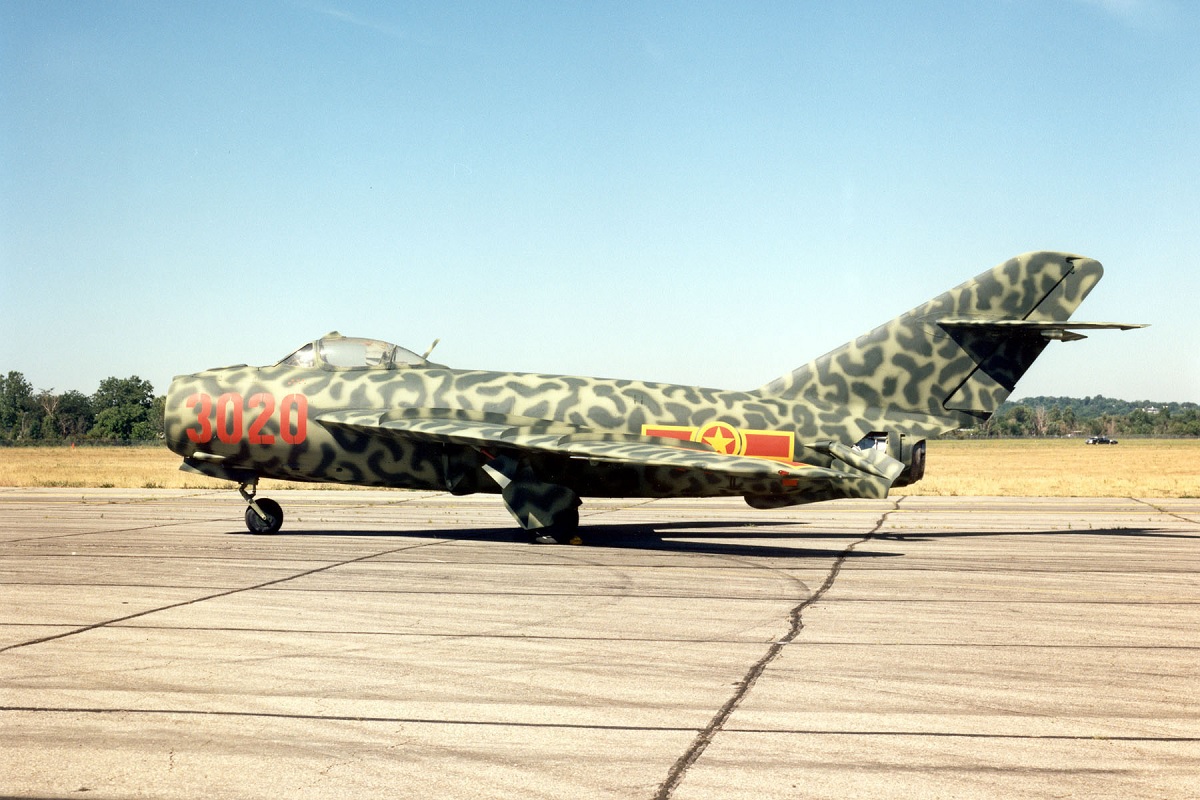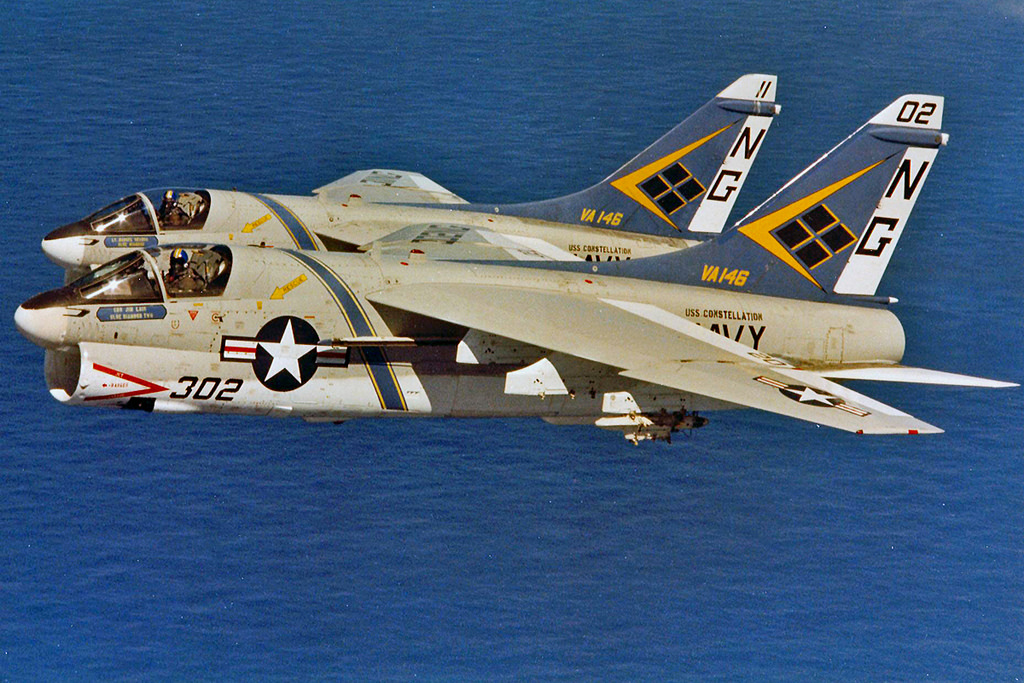Junker’s SLUF lacked the typically present AIM-9D Sidewinder. And to make matters worse, a string of M61 faults on VA-146 caused his A-7 to lose its ability to fire. To avoid the MiG-17, he would have to rely on his flying prowess
The A-7 Corsair II, built by LTV Aerospace Corporation (the same company that made the renowned F-8 Crusader), took the role of the A-4 Skyhawk as the primary light attack aircraft for Naval Aviation. The A-7 made its first flight in September 1965 and had many characteristics of the F-8 Crusader, particularly the single jet intake gaping beneath the nose.
But the Corsair II’s short and stubby form exuded toughness and made it clear that it was built with bombs in mind. The A-7’s aircrews dubbed it the “Short, Little, Ugly, Fucker” (SLUF), although it really developed into possibly the most effective tactical jet bomber of the Vietnam War.
Dueling with a MiG was something the SLUF wasn’t supposed to undertake, yet it did so during the Southeast Asia War.
On May 10, 1972, the day Operation Linebacker kicked off, an A-7 pilot had one of his most up-close and personal contacts with a MiG.
It should be noted that during the campaign, American aircraft from the U.S. Navy, U.S. Marine Corps (USMC), and U.S. Air Force (USAF) carried out a number of heavy strikes deep inside the enemy’s heart, which was something that the military planners had desired since the early days of Rolling Thunder, more than six years earlier. Navy raids target locations along the coast of North Vietnam, especially the region north of Haiphong and close to the Chinese border.
The majority of Linebacker missions were flown by the Navy, with the A-6 and A-7 serving as the primary attack aircraft. The F-4 squadrons’ crews were also tasked with defending the strike groups from marauding MiGs that were more active in the sky.
In their book U.S. Navy A-7 Corsair II Units of the Vietnam War, Norman Birzer and Peter Mersky relate how on May 10, Lt. Allan E. Junker of VA-146 “Blue Diamonds” launched from USS Constellation (CV-64) on a midday strike against the Hai Duong railway marshaling yards, which connected the port of Haiphong to the industrial section of Hanoi. He was flying an A-7E and had eight 500 lb bombs on board.
As he got closer to the target, he questioned why no SAMs had been observed, which is often a sign of MiG activity. He lowered his weapons and turned to face the coast after his strike group. As his flight commander was nowhere to be found, Junker was on his own.

Unbeknownst to him, a MiG-17 allegedly piloted by seasoned pilot Duong Trung Tan had targeted Lt. George T. Goryanec of VA-147. Junker noticed what appeared to be an A-6 approaching him as he moved for the sea. Right up until the silhouette turned into a North Vietnamese MiG-17 “Fresco,” he was excited about the promise of the firm. It was Duong Trung Tan, who had recently attempted to kill Lt. Goryanec but had abandoned the mission as the latter turned his SLUF to face the looming MiG.
However, Junker’s aircraft was lacking the regular AIM-9D Sidewinder because all Sidewinders had been delivered to the F-4 squadrons due to a lack of AIM-9Ds. And to make matters worse, a string of M61 mishaps on VA-146 caused his jet to be without a functioning cannon. To avoid the MiG, he would have to rely on his flying prowess.
Lt. Junker dove for the deck after radioing that a MiG-17 was tracking him. The characteristics of the MiG-17 had been made known to pilots during pre-deployment training. They were aware of its unquestionable superiority over the A-7 and how much faster it was. Additionally, its three-nose cannon had a powerful punch. They were also aware that the MiG’s roll rate was significantly lower than the Corsair II’s, so Junker had to work with this advantage.
He swept across the countryside of North Vietnam at very low altitudes (below 100 feet), cottages and meadows flashing by at more than 500 knots as he jinked up and down in a sine-wave pattern. In his rearview mirrors, he could make out the silver-grey MiG, and he could see that he was getting close to the sea. Junker yanked firmly. Red golf ball-sized shells the size of MiG bullets were being fired, and they were so close to the A-7’s cockpit that Junker could hear the muzzle blast. He wondered, “How will it feel when my wing comes off at 500 knots?”
The desperate A-7 pilot, pulling more than six Gs, threw his aircraft to the left and then to the right in an effort to obstruct the MiG pilot’s aim. The MiG had moved up above him and was now turning to the left to re-engage the Corsair II at his “two o’clock.” Junker could make out the MiG’s top.

As his squadronmate struggled for his life, his Executive Officer (XO), Cdr. Fred Baldwin was now standing over him. Baldwin, like Junker, lacked a Sidewinder and a functional gun, thus the XO was limited to providing moral support and making turn calls for his less-experienced pilot. Then, it’s said that George Goryanec, who was still nearby, heard Cdr. Baldwin’s warning shouts to Lt. Junker and activated the MiG. He hurriedly fired multiple bursts of 20 mm fire at the communist jet, potentially hitting the fighter’s wings (Goryanec was piloting a VA-147 aircraft, and this unit had not encountered any issues with its gun).
Baldwin’s phone calls were helpful, and Junker managed to repel the MiG. The A-7 was now traveling back toward Hanoi as a result of the frequent reversals, which Junker did not desire. He leveled off and stuffed his jet’s nose down once more. Junker soon created a 2000-foot distance between himself and the MiG as he started to outrun the aircraft. The miffed MiG pilot reversed course as he approached the coast, leaving Allan Junker to return to “Connie” and receive a warm welcome.
“People shook my hand and hugged me,” he recalled. From takeoff to landing, the entire sortie had barely taken 1.6 hours.
The rest of the tale was revealed sometime later during a fortuitous encounter between an F-4B pilot and one of Junker’s squadronmates at an officer’s club. Lt. Ken Cannon and Lt. Roy Morris (RIO) of VF-51 off the Coral Sea had heard Junker’s furious engagement on their radio as they were coming off another strike. Lt. Cdr. Chuck Schroeder and Lt(jg) Dale Arends (RIO), along with their flight leader, sped toward the battle and discovered a MiG returning home.
There was some proof that the MiG’s pilot, Duong Trung Tan, was still prepared for combat. Although the MiG pilot immediately moved into a favorable position behind the Phantom II and engaged Cannon’s flight lead, he chose not to fire. He most likely used all of his ammo on the A-7. Cannon approached the MiG-17 from behind and downed him. However, according to a different version of this event, Duong Trung Tan had really gone back to his post in Kep after being wounded by Lt. Goryanec.

Despite all of this aerial combat, on May 23, 1972, a MiG-21 claimed to have shot down an A-7 for the North Vietnamese. American records do not support the allegation, which is a recurrent point of contention. On that day, A-7B BuNo 154405 from VA-93 was lost and formally attributed to a SAM attack. After his death, Cdr. Charles E. Barnett’s remains were returned in 1988. When Barnett was a lieutenant commander and flying an A-4 with VA-195 in December 1966, he managed to avoid being shot down by a SAM.
Photo by skyhawkpc (Flickr) via hiveminer.com, Lt. Graves / U.S. Navy, and U.S. Air Force

